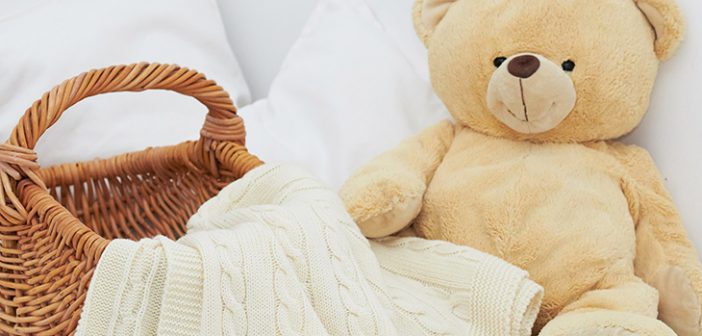A soothing pink or blue? Or maybe a neutral yellow or a mix of light pastels? Honestly, it’s going to look and feel amazing whatever color you choose. But before deciding a color, you might first consider the type of paint you’ll use. Ideally, you’ll want to choose a paint made from natural ingredients and that is free from harmful chemicals — especially if you’re painting while pregnant.
For context, we’ll quickly cover which of the more common paint and stain options to avoid. Then we’ll talk about the less common — but far healthier — natural paints and stains that you may not have realized were an option.
Spoiler alert: Not only are natural paints safer for you and the baby, but their natural colors are some of the most beautiful and soothing you’ll find.
Also read: The Healthiest Baby Crib Mattresses are Made from Natural Materials. Here’s What to Look For.
In this article
- Paints to avoid when pregnant or nursing
- Choosing natural paints (from plants, milk protein, and clay)
- Natural plant oils and waxes
Paints to avoid when pregnant or nursing
You probably already know to avoid oil-based paints, since they contain petroleum-based ingredients and harsh solvents that emit strong fumes. But if you plan to refinish a wooden baby crib or rocking chair, remember that most stains are also oil-based and can emit strong fumes.
The vapors from oil-based stains and paints — and some latex paints — can burn your eyes and cause some pretty serious headaches, as well as dizziness, fatigue, and nausea. The fumes can also linger for ages, off-gassing slowly, even after you stop smelling them.
Obviously, this is no bueno for the baby’s room — or any room of the house, if you ask me — so let’s move on to latex.

Latex paint is a healthier option, but…
Latex (water-based) paints are considered a safer option than oil-based paints, especially if the latex is [tooltip tip=”VOC stands for Volatile Organic Compounds”]VOC-free[/tooltip]. The thing is, most zero-VOC paints still contain other (non-VOC) chemicals and can still emit unwanted fumes.
Also, the paint itself may be free from VOCs, but the color you add may contain them. So if you do choose VOC-free paints, be sure to check the manufacturer’s website to make sure their colors are also VOC-free.
Also, be wary of latex paints that are marketed as “antibacterial”, “antimicrobial” or “mildew resistant”. These features sound appealing at first glance, but check the back of the label or website to read the ingredients before buying.
You’ll either notice that it takes harmful chemicals to achieve these seemingly beneficial characteristics. Or you won’t be able to find the ingredients at all. Transparency is important. So if the paint manufacturer isn’t front-and-center with their ingredients, consider choosing another brand.
And transparent or not, if you’re pregnant or nursing and do choose latex paints, you may want to let someone else do the painting just to be safe.
A note on VOC-free paints
By the way, I’ve checked a ton of VOC-free paint brands and couldn’t find the full ingredients list. Most will simply say “100% acrylic” and say that titanium dioxide is used as their base color. That’s it. And in case you’re curious, acrylic is a plastic made from petrochemicals.
Choosing natural paints
Natural paints are a wonderful choice for painting the nursery — or painting any room, if you’re pregnant or nursing. Truly natural paints are made entirely from plants, milk protein (casein), and/or clay. These natural alternatives do not produce harmful fumes and are safe around babies and pregnant and nursing women.
Typical ingredients you can expect to see on the label include natural limestone, titanium dioxide, diatomaceous earth (fossilized remains of algae), and natural (usually plant or mineral-based) pigments.
One thing to consider is that while the natural paint may be MADE FROM plants, minerals, milk, or clay, the manufacturer can still add chemical colorants. With that in mind, always check the label or website.
So, like the paint itself, you’ll want to look for pigments that come from plants, clay or minerals to ensure your final paint product is chemical-free.
Good to know
Natural paints are more expensive than latex, but if you’re only painting a room or two, the overall cost difference is small. And while pregnant and nursing women should avoid rooms that have been freshly painted with latex or oil for several days, they do not need to avoid rooms painted with all-natural paints.
Natural plant oils and waxes
While most oil stains sold at big box hardware stores emit harsh fumes, conditioning plant oils and waxes are a safer option. Hemp oil, walnut oil, tung oil, caranuaba wax, and beeswax are commonly used as natural alternatives. These options won’t exactly ‘stain’ your wood furniture however, they will add depth to the wood while simultaneously nourishing and protecting it.
[accordions][accordion title=”Research” load=”hide”]
- http://www.builditgreen.org/attachments/wysiwyg/22/Paint.pdf
- http://greenhomeguide.com/know-how/article/selecting-green-paint
- http://des.nh.gov/organization/commissioner/pip/factsheets/ard/documents…
- http://www.epa.gov/kidshometour/products/bpaint.htm
- http://americanpregnancy.org/pregnancyhealth/paintexposure.html
- http://www.nhs.uk/chq/Pages/2531.aspx?CategoryID=54#close
- http://www.cdph.ca.gov/programs/hesis/Documents/toluene.pdf
- http://www.consumerreports.org/cro/magazine-archive/march-2009/home-gard…
- http://www.youtube.com/watch?v=5T1N0ksw3a8
- http://homerepair.about.com/od/interiorhomerepair/ss/low_voc_paint_5.htm
- http://www.greenseal.org/Portals/0/Documents/Standards/GS-11/gs11_one_pa…
- http://greenhomeguide.com/askapro/question/i-am-remodeling-my-home-and-r…
- http://www.ewg.org/skindeep/ingredient/706561/TITANIUM_DIOXIDE/
- http://www.milkpaint.com/about_art-fw.html
[/accordion][/accordions]

